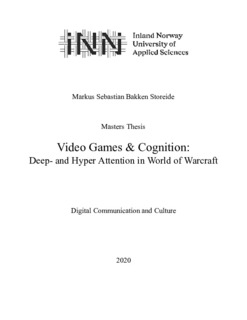| dc.contributor.author | Storeide, Markus Sebastian Bakken | |
| dc.date.accessioned | 2020-12-09T11:20:40Z | |
| dc.date.available | 2020-12-09T11:20:40Z | |
| dc.date.issued | 2020 | |
| dc.identifier.uri | https://hdl.handle.net/11250/2713475 | |
| dc.description | Mastergradsoppgave i digital kommunikasjon og kultur, Høgskolen i Innlandet, 2020. | en_US |
| dc.description.abstract | English:
This thesis investigates N. Katherine Hayles’ proposed cognitive modes of deep- and hyper attention, and their possible relations to the video game World of Warcraft. It is an interdisciplinary study between game studies and cognitive/psychological studies, to create a comparative understanding of the cognitive activity within video games in relation to Hayles’ theoretical proposals. Game theorists like that of Jesper Juul and Tanya Krzywinska provide the guidelines and theories for video game research, and cognitive theorists like Anne Treisman are the theoretical foundation for discussing cognition.
To include research where these fields are united, it also applies the theoretical perspective of Astrid Ensslin, as her research on literary gamin g in terms of the relationship between literary and ludic elements have connections to Hayles’ cognitive theory, and discusses the possible implications of her cognitive modes in this relationship.
The purpose has been to investigate how the different cognitive modes of Hayles are stimulated in World of Warcraft , based on their described characteristics. As such, it takes a close look at how World of Warcraft presents information to its players, what information this is, and how it relates to the players current gameplay activity. From these observations, it makes a comparative look to the characteristics described in Hayles’ theory to discuss how the cognitive modes are stimulated within the video game.
Furthermore, it theorizes the cognitive relation between inside and outside video games, as the emergence of cognitive activity between the real world and the world of make believe are elusive to conclusive results. This is an issue in game studies as a whole, and as such I lean on Huizinga's terms of the magic circle and Salen & Zimmerman’s immersive fallacy to provide possible theoretical solutions to this issue. | en_US |
| dc.description.abstract | Norsk:
Denne oppgaven undersøker de foreslåtte kognitive modusene; dyp- og hyper oppmerksomhet av N. Katherine Hayles, og deres forhold til dataspillet World of Warcraft. Det er en tverrfaglig studie mellom spillstudier og kognitive/psykologisk forskning, med mål for å skape en omfattende forståelse av den kognitive aktiviteten i dataspill i forhold til Hayles foreslåtte teorier. Spillforskere som Jesper Juul og Tanya Krzywinska gir retningslinjer og teorier om kvalitativ forskning på dataspill, og kognitive teoretikere som Anne Treisman er det teoretiske fundamentet for diskusjonene om kognisjon. For å inkludere forskning der disse feltene møtes, anvender oppgaven også det teoretiske perspektivet til Astrid Ensslin, ettersom hennes forskning på litterære spill i henhold til forholdet mellom litterære og ludiske elementer har tilknytninger til Hayles kognitive teori, og diskuterer de mulige implikasjonene disse kognitive modusene kan ha i dette forholdet.
Målet har vært å undersøke hvordan de forskjellige kognitive modusene til Hayles blir stimulert i World of Warcraft , basert på de teoretiske kjennetegnene. Som sådan, undersøker oppgaven hvordan World of Warcraft presenterer informasjon til spillerne, hva slags informasjon dette er, og hvordan dette forholder seg til deres aktuelle spillaktivitet. Fra disse observasjonene, drar oppgaven sammenligninger til Hayles sin teori for å diskutere hvordan de kognitive modusene blir stimulert i dataspillet.
Videre, vil oppgaven komme med diskusjoner om det kognitive forholdet mellom utsiden og innsiden av dataspill, ettersom utmerkelsen av forholdet til den kognitive aktiviteten mellom virkeligheten og fiksjon kan gi mangelfulle konklusjoner. Dette er et kjent problem innen spillforskning, så jeg trekker derfor inn Huizingas ide om den magiske sirkel og Salen & Zimmermans immersive fallacy som mulige teoretiske løsninger til dette problemet. | en_US |
| dc.language.iso | eng | en_US |
| dc.subject | DIGKOM | en_US |
| dc.subject | World of Warcraft | en_US |
| dc.subject | dataspill | en_US |
| dc.subject | oppmerksomhet | en_US |
| dc.subject | kognitiv aktivitet | en_US |
| dc.title | Video Games & Cognition: Deep- and Hyper Attention in World of Warcraft | en_US |
| dc.type | Master thesis | en_US |
| dc.source.pagenumber | 255 | en_US |
